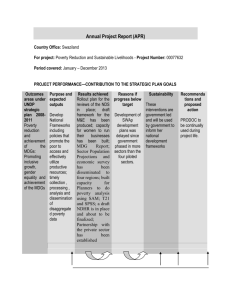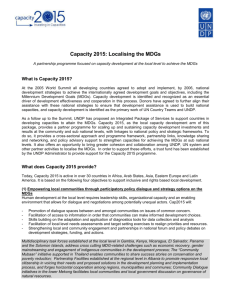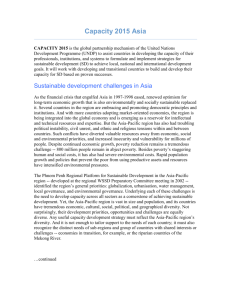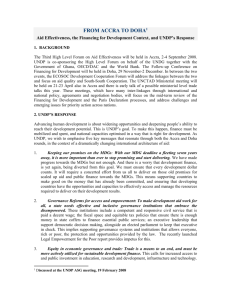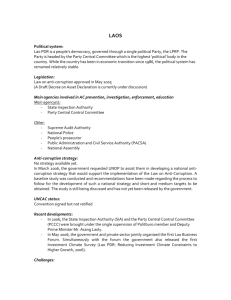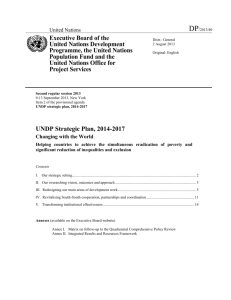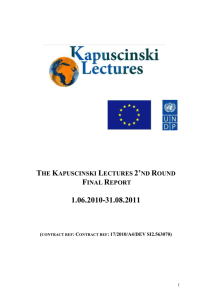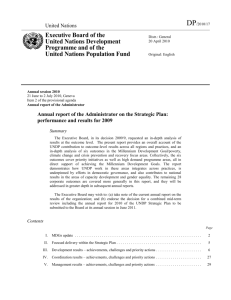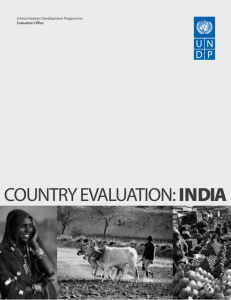Capacity 2015 in Latin America - UNDP in Latin America and the
advertisement
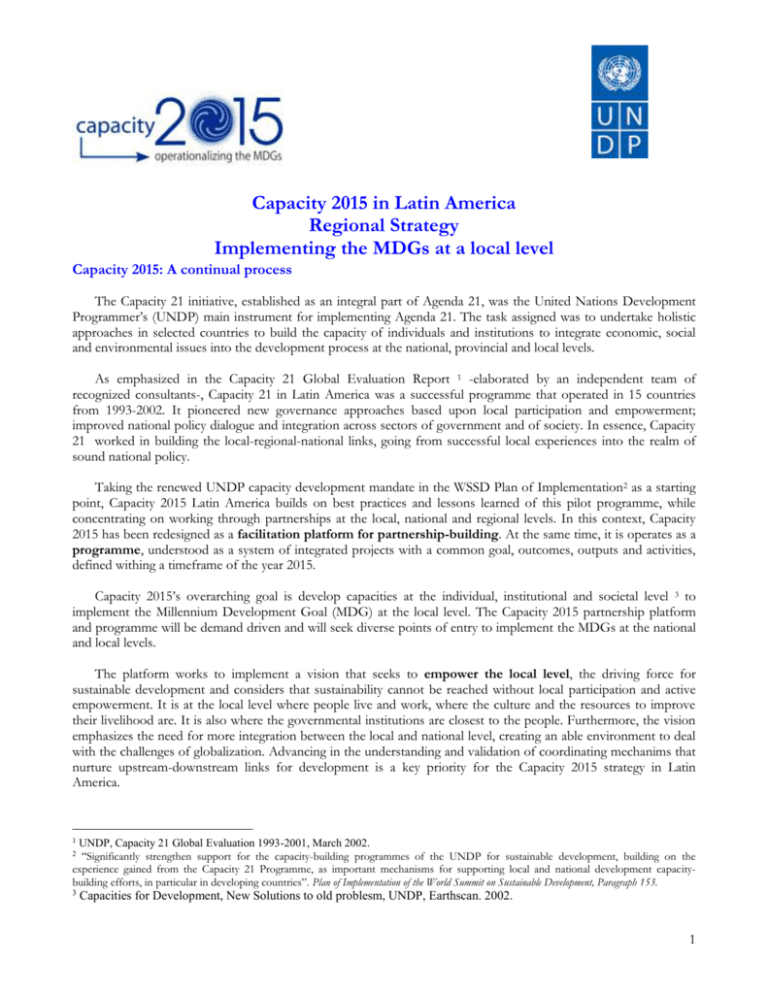
Capacity 2015 in Latin America Regional Strategy Implementing the MDGs at a local level Capacity 2015: A continual process The Capacity 21 initiative, established as an integral part of Agenda 21, was the United Nations Development Programmer’s (UNDP) main instrument for implementing Agenda 21. The task assigned was to undertake holistic approaches in selected countries to build the capacity of individuals and institutions to integrate economic, social and environmental issues into the development process at the national, provincial and local levels. As emphasized in the Capacity 21 Global Evaluation Report 1 -elaborated by an independent team of recognized consultants-, Capacity 21 in Latin America was a successful programme that operated in 15 countries from 1993-2002. It pioneered new governance approaches based upon local participation and empowerment; improved national policy dialogue and integration across sectors of government and of society. In essence, Capacity 21 worked in building the local-regional-national links, going from successful local experiences into the realm of sound national policy. Taking the renewed UNDP capacity development mandate in the WSSD Plan of Implementation2 as a starting point, Capacity 2015 Latin America builds on best practices and lessons learned of this pilot programme, while concentrating on working through partnerships at the local, national and regional levels. In this context, Capacity 2015 has been redesigned as a facilitation platform for partnership-building. At the same time, it is operates as a programme, understood as a system of integrated projects with a common goal, outcomes, outputs and activities, defined withing a timeframe of the year 2015. Capacity 2015’s overarching goal is develop capacities at the individual, institutional and societal level 3 to implement the Millennium Development Goal (MDG) at the local level. The Capacity 2015 partnership platform and programme will be demand driven and will seek diverse points of entry to implement the MDGs at the national and local levels. The platform works to implement a vision that seeks to empower the local level, the driving force for sustainable development and considers that sustainability cannot be reached without local participation and active empowerment. It is at the local level where people live and work, where the culture and the resources to improve their livelihood are. It is also where the governmental institutions are closest to the people. Furthermore, the vision emphasizes the need for more integration between the local and national level, creating an able environment to deal with the challenges of globalization. Advancing in the understanding and validation of coordinating mechanims that nurture upstream-downstream links for development is a key priority for the Capacity 2015 strategy in Latin America. 1 UNDP, Capacity 21 Global Evaluation 1993-2001, March 2002. “Significantly strengthen support for the capacity-building programmes of the UNDP for sustainable development, building on the experience gained from the Capacity 21 Programme, as important mechanisms for supporting local and national development capacitybuilding efforts, in particular in developing countries”. Plan of Implementation of the World Summit on Sustainable Development, Paragraph 153. 2 3 Capacities for Development, New Solutions to old problesm, UNDP, Earthscan. 2002. 1 The lessons of Capacity 21 have been fully mainstreamed in UNDP’s Regional Bureau for Latin America and the Caribbean (RBLAC), and it is located inside its ‘Human Development at the Local Level’ service line4. Capacity 2015 will move from the pilot level to RBLAC’s main tool for the implementation of the MDGs at the local. Capacity 2015, in its initial stage, will work with 8 countries in the region. Bolivia, Costa Rica, Ecuador, El Salvador, Nicaragua, Panama, Paraguay and Venezuela. The medium-term goal is to offer its services to all the countries in Latin America. The ‘richer’ countries in the region will be able to access funding for action in its ‘pockets of poverty’. The regional activities of the facility will mainly promote interchange of Knowledge Management products based on experiences and lessons between countries and regions to enhance the effectiveness of national and local action. In order to achieve this Capacity 2015 is launching an aggressive global mechanism known as the ILN (Information Learning Network). The ILN represents UNDP’s forefront of creative thinking for capacity building to tackle the opportunities and threats of globalization, through the combination of strengths from civil society organizations (CSO) and universities. This approach recognizes the differentiated knowledge that is conveyed by different actors, and the mutual benefits of exchanging it in the context of unsolved local needs.5 ILN will deliver in four specific areas with emphasis on the local level: Knowledge management, learning and capacity development, networking and mutual discovery, advocacy and outreach.6 Support at the national level At the national level, Capacity 2015 will concentrate on the following four core areas of intervention. Sustainable Local Economies The Inter-American Development Bank, the GEF’s Small Grants Programme (SGP) and Public Private Partnerships for the Urban Environment (PPPUE) were proven valuable partners for Capacity 21. In close association with these and other relevant partners, especially the regional development banks, Capacity 2015 will encourage the development of sustainable local economies by promoting and seed-funding investment and employment strategies formulated in an enabling environment in which local populations manage their own development. This includes participatory approaches for the selection of the local projects (bottom-up and ownership oriented), linking projects with processes, selecting appropriate technologies, developing productive chains, strengthening internal local markets, and putting the right emphasis on the economic aspects of sustainable development. Leadership for Local Development.- Individual capacities for local sustainable economies. With assistance of the Leadership for Environment and Development (LEAD) programme, the UNDP HIVAids leadership programme, and other qualified partners, Capacity 2015 will assist in the development of individual capacities to encourage the emergence of local leaders with the skills, understanding and knowledge to approach development issues in an innovative and integrated manner. Concrete sustainable development problems derived from the field will be analyzed in formal and informal educational settings where new knowledge and innovative solutions will be generated and implemented. Human Development at the Local Level integrates all RBLAC service lines, including, among others, governance, gender, poverty and environment.. 4 5 6 Al Binger, Concept paper for operationalizing CAPACITY 2015, Draft07, July 2003 Strategy and Workplan for the Information Learning Network (ILN), Draft, p. 10 2 Platforms for Local Governance- Building institutional capacities. In partnership with the International Council for Local Environmental Initiatives (ICLEI), the Earth Council, and local governments, Capacity 2015 will assist municipalities to improve governance by means of creating and/or improving platforms where local actors (local government, private sector, civil society) can jointly plan for development. One of the main features of this area will be to build and strengthen a Capacity 2015 ICT platform and human network for the exchange of information, successful experiences, best practices and lessons learned. National Policy for Local Development. Societal Capacity Development. In close partnership with Economic Commission for Latin America and the Caribbean (ECLAC) and other policy-oriented agencies, Capacity 2015 will aim to work with key policy and decision-makers to strengthen policy support for local development. The dynamic will work in both directions, i.e. from bottom to top, and from top to bottom. Based on successful local programmes, recommendations will be derived for new policy. Backed by existing good policy, new programmes at the local, regional and national levels will be implemented. A permanent learning process on the connections between successful local projects and sound national policy will be put into place.7 Through Capacity 2015, UNDP will facilitate a continuous platform to develop, effectively utilize and retain capacities at all levels, although focusing mostly at the local level. The above can be visualized in the following figure. fo r y lic Po al ce a rn ve tio n go Na al Local Sustainable Economies loc Lo or ca sf MDGs rm MDGs fo at lD Pl ev el op m en t Capacity 2015 in LA – The platform MDGs Leadership for Local Development 7 UNDP, BDP, CDG, Practice Note. Upstream-Downstream links for Development, Draft13, May 2004. 3 Local Sustainable Economies are at the core of the figure. They are supported by a three-prong system including National Policy for Local Development, Local Platforms for Development, and Leadership for Local Development. Each area of intervention functions as an entry point that can operate independently, but the more come into play and interact, the stronger the synergy will operate towards sustainable development. From the perspective of capacity development, the individual level is covered by leadership for local development; the institutional dimension, by strengthening municipalities; and the societal level, by the national policy that includes local development. How will the platform function? A Regional Steering Committee (RSC), composed of a representative of each of the partners, will be responsible for the strategic direction of the facility and national programme approbation. Their main functions will be: o o o o o Provision of strategic directions to ensure that the Cap2015 platform, programme and projects are consistent with the principles, objectives and approaches set forth in the Cap2015 Global strategy, while contributing directly to the attainment of the MDGs; Provide substantive oversight and technical guidance to ensure that programmes are being implemented effectively and that resources are efficiently utilized. Approve programmes and projects proposals for funding under the Cap2015 platform; Pursue and maintain active relations with donors for Cap2015, contribute to the design of the Cap2015 regional resource mobilization strategy, maintain and establish contacts, open doors, represent and disseminate the Cap2015 vision and image through the region. Foster strategic partnerships to ensure national and inter-regional cross-fertilization of capacity development ideas, experience, knowledge and skills, including the effective operationalization of the Cap2015 Information and Learning Network (ILN). The Capacity 2015 Regional Coordination team will function as the Secretariat of the RSC. At the national level, the UNDP Country Offices will facilitate the partnerships that will, among others be operationalzed by national programm 2004-05-14 4

